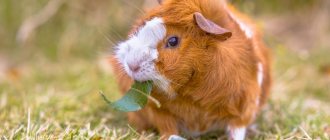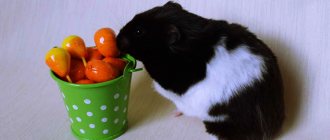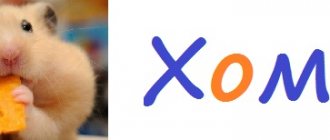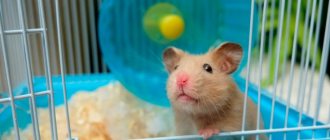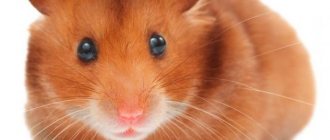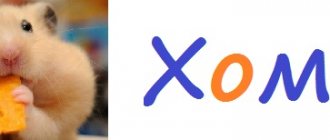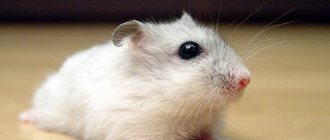To begin with, once again I want to congratulate you - you are very good owners if you first ask what you can give your hamster and what you can’t, and only then feed it to him. Or don't feed. Most people don’t worry about the diet of their Syrian or Djungarian at all. They just shove anything into his feeder. And hamsters are very gentle creatures. You can't do that with them.
Should you include tomatoes in your hamster's diet?
Considering that the vegetable is so rich in nutrients, experts advise offering it to hamsters, but contraindications must also be taken into account:
- there may be manifestations of allergic reactions;
- if digestive disorders have been observed, they may increase (diarrhea, flatulence, dehydration);
- joint diseases, pancreatitis, gout, if the pet has them, are aggravated.
Hamster and cherry tomato
Tomatoes grown in your own garden are best. Greenhouse vegetables out of season should not be given to animals, as the fruits can absorb large amounts of nitrates, which are used for indoor cultivation. In any case, it is better to remove the skin from tomatoes, since it contains a higher content of harmful substances. Green nightshade fruits, which include tomatoes, contain poisonous solanine, so unripe vegetables are also not suitable for feeding hamsters.
In winter, it is even more impossible to replace fresh tomatoes with canned, salted and pickled ones. They contain too much salt and other preservatives (such as vinegar), which will create excessive stress on the digestive and excretory systems of rodents. Dried fruits, tomato paste and juices create a high concentration of acids, which is also harmful for hamsters.
What hamsters can and cannot do, food list
List of food groups for hamster nutrition
Must be given continuously as food
Dry food for hamsters, legumes except red beans, raw and cooked cereals except rice. Rice is given for diarrhea. Vegetables: root vegetables except potatoes, in season cucumbers and peppers, zucchini, pumpkin. Dill, parsley, lettuce, dandelion. Fruits are sweet, seasonal, seedless. Home dried fruits. Frozen vegetables without onions. Pumpkin, sunflower, melon seeds. Nuts other than almonds and apricot kernels should be given not as the main food, but as a supplement, since nuts are fatty. Sprouted oats, wheat. Branches of deciduous trees boiled for 20 minutes, but not from the street.
You need to give one of the positions to choose from 2-3 times a week
Boiled chicken breast without salt and other spices; low-fat lactic acid products (fat content no more than 1%); boiled egg white; very rarely meat or boiled shrimp; insects and gammarus purchased in the store; lean boiled fish without bones.
Can't give
Fried, smoked, salted, pickled, fatty. Sugar, salt, spices, honey. Cream, sour cream and butter. Pasta: both dry and boiled. Citrus fruits, persimmons, onions and garlic, radishes, potatoes, acorns, cabbage, eggplant, tomatoes. Coniferous branches. Insects from the street, bloodworms. Mushrooms, mint and rose hips.
The table gives general principles on how to feed a hamster; based on them, create your pet’s diet.
Salted and pickled vegetables are completely unsuitable for hamsters. Salt, spices and vinegar are strictly prohibited. And it’s unlikely that the animal will touch them when trying to treat it. In addition, the lack of information about the place and methods of cultivation does not guarantee that an environmentally friendly product is being purchased.
Black and white bread
In natural wild conditions, bread is inaccessible to rodents, unless they live near populated areas. Only domestic hamsters can enjoy it, but veterinarians unanimously do not recommend feeding them fresh flour products.
White flour is made from wheat, which is always present in dry mixes, and is acceptable and healthy for your hamster. However, in the process of grinding and processing, grain changes not only its structure, but also its qualitative composition. The product is additionally bleached to make it look presentable and last longer. As a result, the flour is deprived of most of its vitamins, minerals and beneficial fiber.
The resulting starch is a heavy carbohydrate; it can cause obesity in a hamster and, as a result, diabetes, as well as joint problems. In addition, it has the following negative effects on the body:
- negatively affects the functioning of the urinary system;
- provokes disruptions in the normal functioning of the adrenal glands and pancreas;
- leads to disruption of the endocrine system (thyroid gland).
Yeast is added to the dough kneaded for bread, as well as leavening agents, flavorings, stabilizers and other synthetic additives. A hamster's consumption of these completely unhealthful components is fraught with digestive disorders, manifested by increased gas formation and even (in rare cases) alcohol poisoning (due to yeast fermentation). Yeast is especially dangerous because it can radically change the intestinal microflora.
If you give a hamster bread, he will develop quite painful conditions:
- flatulence, vomiting, nausea;
- diarrhea;
- refusal to eat due to loss of appetite;
- breathing problems (choking);
- lethargy and decreased activity;
- heart failure;
- disorientation;
- and even death.
The same attitude applies to black bread, because it is also made with yeast. Although rye flour is less starchy, and there is no need to bleach it, hamsters still cannot eat baked goods from it. The ban is associated with the increased acidity of the baked product, due to which disturbances in the gastrointestinal tract are observed. If you give a hamster rye or black bread, it can cause:
- heartburn;
- gastritis;
- constipation;
- colitis;
- ulcer.
Crackers
If fresh bread has no place on the hamster’s menu, then the attitude towards crackers is different. After all, during heat treatment (drying in an oven), most of the yeast fungi die. Dried bread pieces (both wheat and rye) contain enough fiber, much less carbohydrates, and also contain a number of essential and beneficial minerals (Mg, Fe, Ca). Considered dietary, dried bread no longer causes fermentation; when consuming it, the hamster does not experience flatulence. Rusks normalize the functioning of the gastrointestinal tract and restore metabolic processes in the endocrine system.
On store shelves there is a huge assortment of crackers already prepared and packaged in beautiful wrappers; it is tempting to buy and pamper your pet hamster with them. But this should not be done under any circumstances, since all sorts of flavor enhancers, flavorings and stabilizers are added to purchased products at the factory. These substances, even in small quantities, are deadly to small rodents. It is more desirable and much safer to dry bread yourself, giving preference to grain and bran products.
Can Syrian hamsters and dwarfs eat tomatoes?
Another negative point is that tomatoes are not recommended for those with joint problems. And Syrians are prone to arthritis. Hence the conclusion: Syrian hamsters should not be given tomatoes. Or very rarely and in small pieces. With dzhungariki everything is a little simpler, there the situation is like with a pear - they gave a piece and saw what happens. If everything is in order, we feed the Djungarian hamster with tomatoes without any special worries.
If I don’t eat it all at once, I’ll at least take a bite!
What happens if a hamster eats a lot of tomatoes?
Excessiveness is almost always harmful; in this case, overeating can have the following dangerous consequences:
- allergic reactions (itching, tearfulness, swelling, shortness of breath);
- indigestion (diarrhea, bloating);
- dehydration.
Such manifestations can even lead to the death of the pet.
We can conclude that it is worth including tomatoes in the diet of hamsters, but carefully and carefully, adhering to the norm and taking into account the recommendations of experts. Grain mixtures form the basis of a hamster's daily diet.
Grain foods are very nutritious; they contain a large amount of vitamins necessary for the active lifestyle of a rodent. But feeding your hamster grain alone is not recommended. For growth and development, it also needs other nutrients and minerals that are found in vegetables, fruits and berries.
Grain mixtures form the basis of a hamster's daily diet. Grain foods are very nutritious; they contain a large amount of vitamins necessary for the active lifestyle of a rodent. But feeding your hamster grain alone is not recommended. For growth and development, it also needs other nutrients and minerals that are found in vegetables, fruits and berries.
Despite the fact that hamsters are omnivores, you should never give them everything. At home, the diet of rodents should be as close as possible to the diet in the natural environment. In nature, hamsters independently choose their food and determine their daily intake. In captivity, the owner is responsible for feeding the hamster.
Vegetables are not only rich in vitamins and minerals, but also contain high amounts of fiber, which improves digestion and promotes the absorption of food. Some vegetables need to be fed daily, others can be given no more than 1-2 times a week. Also, not all vegetables are equally beneficial for the rodent’s body. Some of them can be harmful to health and have a detrimental effect on the health of the pet, since the digestive system does not digest fibers that are not intended for the hamster's stomach.
Root vegetables (potatoes, beets, carrots)
Some of them are necessary for the animal every day, others only occasionally. It is also important in what form the rodent receives this or that vegetable. The basic principle is the same as in human nutrition: the less heat treatment a product is subjected to, the more useful substances are preserved in it.
Potato
Veterinarians clearly agree that the vegetable is not recommended for a hamster due to its high starch content. In small quantities, you can occasionally pamper your pet with them - it is acceptable to offer him raw or boiled potatoes, but not fried ones.
Only young potatoes (not green) without pesticides and nitrates are useful for the animal.
Beet
This vegetable is not recommended, but it is occasionally given fresh or boiled to Syrian hamsters. The cube should be no larger than a button, and they start with even smaller sizes in order to track the reaction of the gastrointestinal tract. If tolerance is normal, the portion is increased.
Keep in mind that there are three types of beets - fodder, table and sugar; hamsters are given the second option. The first contains practically no useful substances for the rodent, and the third can lead to diabetes mellitus, especially in Djungarians.
Carrot
It is not only possible, but must be given to the hamster; it is an essential ingredient in the daily diet. A mug 1.5 cm thick is enough for one approach - no more is needed, otherwise the rodent will start making supplies that will quickly spoil.
The best option is to treat your hamster with raw carrots; sometimes it is permissible to diversify the menu with boiled carrots. In addition to vitamins A, C, K, it is rich in dietary fiber, which is beneficial for digestion, and potassium for the heart muscle.
It is recommended to pre-soak all store-bought vegetables in water, this helps remove nitrates and other chemicals from them. Hamsters are sensitive to them, and due to their small size they can be poisoned by even a small portion of vegetables that have absorbed harmful substances.
Sometimes you can put 1 tablespoon of carrot tops in the animal’s bowl - it contains 5 times more vitamins than the root vegetable. But not from a store-bought vegetable - its above-ground parts are often treated with pesticides against pests, which is fatal to the rodent. If it is not possible to treat your pet to greens from your dacha, it is better to buy parsley, celery or lettuce at the supermarket - they are safer for your pet.
Radish
Recommended in small portions 1-2 times a week. Give preference to country vegetables or vegetables grown in your own beds. They contain folic acid, which is especially important for pregnant females; they effectively cleanse the liver and normalize the flow of bile. Pectin cleanses the body of toxins, and its low calorie content makes radishes a dietary product.
Turnip
The root vegetable is useful in all respects, especially for Syrians prone to arthritis - turnips contain substances that protect joints from inflammation. Helps with osteoporosis, serves as a source of potassium and calcium for bones.
Harmful properties
But tomatoes do not always have a positive effect on the health of the rodent. There are a number of contraindications in which consumption should either be limited or excluded from the rodent’s diet altogether. The product cannot be used in cases where:
- The hamster is prone to frequent stomach upsets (diarrhea, diarrhea). The disease is scary because it can lead to dehydration or rectal prolapse.
- Do not give simultaneously with foods high in protein. All together this leads to a slowdown in the digestion process and bloating and flatulence.
- Excluded from the diet if the animal is sick with arthritis or gout.
- Never feed your pet unripe vegetables. Green tomato contains dangerous poison. This type of poisoning can be fatal.
- If a rodent is sick with gastritis or pancreatitis, this is also a reason to exclude tomatoes from its diet.
- Do not feed the vegetable to Syrian hamsters. This type of rodent is susceptible to joint pathologies. And eating it can lead to an exacerbation of the disease.
- It may cause an allergic reaction because it contains dyes. When you treat your pet to this product for the first time, carefully monitor its condition. An allergy can manifest itself as watery eyes, shortness of breath, constant scratching of the skin, and redness on the skin. If this does not happen, you can safely feed him vegetables.
Is it possible to give hamsters tomatoes if they are salted or pickled? - Definitely not. They contain a large amount of salt, which is poorly excreted from the rodent's body. Its excess has a bad effect on the functioning of the cardiovascular system. And if a rodent suffers from kidney disease, then kidney stones may develop.
It is also not recommended to give hamsters vegetables bought in the supermarket in winter. Since there is a high probability that they contain large quantities of nitrates and pesticides. There is no need to give him tomato juice, because the concentration of acidity in it is much higher than in fruits, and the amount of liquid can immediately lead to diarrhea.
What are the benefits of tomatoes for a hamster?
Hamsters, like any living creature, need vitamins. Tomatoes will help make up for the deficiency of the following:
| Vitamins | Why are they needed? |
| C (ascorbic acid) | Participates in the synthesis of hormones, protein metabolism, helps fight infections, improves immunity |
| A (retinol) | Promotes wound healing, tissue regeneration, has a beneficial effect on the health of the eyes, respiratory, digestive, and urinary systems |
| E (tocopherol) | Helps cell restoration, protects them (especially nerve cells), participates in the process of hematopoiesis |
| Group B | Necessary for the functioning of all body systems, primarily the nervous and cardiovascular systems, support metabolism (energy metabolism) |
In addition, vitamins and lycopene have a pronounced antioxidant effect, that is, they are able to protect the animal’s body from the effects of free radicals and protect against cancer.
Hamster and tomatoes Normal metabolism, in particular hormonal, strengthening blood vessels and the skeleton is promoted by the minerals contained in tomatoes:
- calcium and phosphorus are included in connective and bone tissues, in the composition of claws and teeth;
- iodine is necessary for the functioning of the thyroid gland;
- potassium and magnesium are involved in the transmission of nerve impulses to muscles (including the heart).
Tomatoes also contain organic acids (malic, citric), which are necessary for good digestion. Fiber, which is found in large quantities in tomatoes, also contributes to the efficient functioning of the gastrointestinal tract.
Benefits of vegetables
The energy value of the vegetable is low, since 95% of it consists of water. But the low calorie content (only 20 kcal per 100 g) does not in any way affect the presence of nutrients contained in the tomato. It contains micro- and macroelements: potassium, magnesium, phosphorus, chlorine, sodium, zinc, copper, manganese. Basic vitamins are also present in the vegetable: vitamin A, C, H. Let's consider how the chemical composition of a tomato has a beneficial effect on the overall health of the pet:
- Antioxidants prevent the growth and development of cancer cells.
- Vitamin C is especially necessary for the baby’s body during the period of vitamin deficiency, after an illness, and simply for the prevention of any colds in general.
- The fiber in the product has a beneficial effect on the functioning of the hamster's gastrointestinal tract. Helps reduce the risk of developing constipation.
- Acids (citric, malic, glycolic) improve appetite. A small amount of the vegetable will be especially useful for a hamster in the third or fourth year of life. It is during this period that they often refuse to eat.
- Positively affects the functioning of the rodent's cardiovascular system. Prevents the risk of thrombosis and atherosclerosis.
- Helps improve the animal's immunity and remove toxins from the body.
- Useful for hamsters suffering from diseases of the genitourinary system - cystitis, pyelonephritis. Folic acid normalizes the water-salt balance in the animal’s body and removes excess fluid and toxins. Responsible for increasing and maintaining immunity.
- Vitamins have a positive effect on the appearance of the rodent’s fur. They make it silky and shiny.
- Iodine normalizes the functioning of the endocrine system and promotes the normal functioning of the thyroid gland.
- Regular consumption of this product normalizes metabolism and avoids diseases of the nervous system.
- For constipation, tomato can be given instead of a laxative. It will help the intestines to empty easily and normalize the functioning of the gastrointestinal tract.
Controversial issues or what not to feed a hamster
There are products that cause controversy among animal owners. Is it possible to give milk to animals, how much cheese can you give, and what harm can crackers and bread do?
To answer these questions, we will have to return to the diet of animals in the wild:
- Adult animals do not feed on milk, and the composition of cow's milk is not suitable for young animals. Babies fed bread soaked in milk survive only due to their potential health, and not due to proper feeding.
- You should not feed your pet hamster cheese. It is quite fatty and contains a lot of salt: this will harm the rodent.
- Bread and baked goods are completely inedible for rodents, although they will chew them. There are too many harmful components in the form of fat and sugar in crackers and cookies. If you decide to feed something similar, choose unsweetened dryers. It won't be too useful, but in minimal quantities it won't cause any harm.
Has the hamster already said “thank you” to you?
Knowledge without practice is useless ballast. Immediately tell the family not to stuff the poor animal with food all day. And if your hamster learns to talk, the first thing he will say to you is: “Thank you very much!”
Return! I'll miss
Would you like to supplement the information in the article and find out what else you can feed your rodent? Leave comments and join us on social networks. Constructive criticism is always welcome!
How to feed
The product, which is given to the hamster for the first time, is introduced gradually, observing its reaction. It's worth starting with 5 grams. If you notice any unpleasant consequences (diarrhea, changes in behavior), stop feeding immediately.
Important! A cherry tomato weighs about 10 grams, enough to feed an adult a couple of times a week.
It has been noted that vegetable complementary feeding is much easier to introduce than complementary feeding with grain products. Grains contain a lot of carbohydrates, they are quite nutritious, so they are more difficult and longer to digest by the digestive system. And vegetable products are easier to digest and absorb in the body. You should give the tomato in the morning, with a bowl of water.
Tomatoes should not be used as food for pregnant animals or females nursing children. In such situations, it is necessary to replace this vegetable with other vitamin products.
A mixture of tomatoes with protein products is not the best option for feeding hamsters. If they don't eat what their owner offers, don't insist. Rodents themselves choose the foods their bodies need.
What can happen if you eat more than you should?
It is not recommended to overfeed the animal. These animals have the habit of hiding food, stocking it up for future use, and at night they can feed on it. Following this, feeding should be done twice a day. Give your pet a larger portion in the evening than in the morning.
A good solution would be to feed succulent foods in the morning, and grains in the evening. Thus, the likelihood of a hamster stocking up on perishable food will be minimal, since it is removed immediately after consumption.
Remember all feeding recommendations when treating your animal to a tomato
This must be done with extreme caution. This way you will prevent health problems for your hamster and help replenish the supply of nutrients in the body.
The health of your pet largely depends on proper nutrition. The basis of a hamster's diet is cereals. But grains and cereals do not contain all the substances necessary for the development and normal functioning of an animal, so vegetables and fruits have to be included in its menu. A large number of vitamins, micro- and macroelements are present in tomatoes.
How much do hamsters eat?
Many people take hamsters as pets because they have cute cheeks. The problem is that they quickly gain weight, and this shortens the life of the rodents. Therefore, please read the nutritional instructions below carefully.
Measure portions correctly!
The hamster is a nocturnal animal. In the evening he has "breakfast" and this should be the main meal of the day. Many people give animal food only in the evening, and there is no mistake in this, but it can be divided into 2 times (give a smaller portion in the morning).
It’s difficult to say how much food a hamster needs every day, it depends on:
- Hamster breeds
- Dimensions
- Health status
- Volume of physical activity
When using ready-made mixtures, it is recommended to give the following portions (these are average values): the daily feeding rate should be 2/3 of the hamster’s weight. Hamsters weighing 100 g should not consume more than 70 g of food.
How to feed?
Tomatoes should be introduced into the hamster’s menu gradually. Start literally with 5 grams, observing the pet’s further reaction. In case of negative manifestations (allergies, diarrhea), stop feeding. For clarity: the average size of a cherry fruit is 10 - 30 grams. This is exactly the one-time norm of tomato complementary feeding for an adult rodent. Giving tomatoes to your hamster 1 - 2 days a week will be enough.
Pregnant and lactating females, as well as cubs, should not be given these vegetables; it is better to choose other vitamin supplements. Tomatoes should not be mixed with protein feed. If your pet refuses to eat vegetables, there is no need to insistently offer them; usually animals instinctively choose what is best for them.
Harmful properties
But tomatoes do not always have a positive effect on the health of the rodent. There are a number of contraindications in which consumption should either be limited or excluded from the rodent’s diet altogether. The product cannot be used in cases where:
- The hamster is prone to frequent stomach upsets (diarrhea, diarrhea). The disease is scary because it can lead to dehydration or rectal prolapse.
- Do not give simultaneously with foods high in protein. All together this leads to a slowdown in the digestion process and bloating and flatulence.
- Excluded from the diet if the animal is sick with arthritis or gout.
- Never feed your pet unripe vegetables. Green tomato contains dangerous poison. This type of poisoning can be fatal.
- If a rodent is sick with gastritis or pancreatitis, this is also a reason to exclude tomatoes from its diet.
- Do not feed the vegetable to Syrian hamsters. This type of rodent is susceptible to joint pathologies. And eating it can lead to an exacerbation of the disease.
- It may cause an allergic reaction because it contains dyes. When you treat your pet to this product for the first time, carefully monitor its condition. An allergy can manifest itself as watery eyes, shortness of breath, constant scratching of the skin, and redness on the skin. If this does not happen, you can safely feed him vegetables.
Is it possible to give hamsters tomatoes if they are salted or pickled? - Definitely not. They contain a large amount of salt, which is poorly excreted from the rodent's body. Its excess has a bad effect on the functioning of the cardiovascular system. And if a rodent suffers from kidney disease, then kidney stones may develop.
It is also not recommended to give hamsters vegetables bought in the supermarket in winter. Since there is a high probability that they contain large quantities of nitrates and pesticides. There is no need to give him tomato juice, because the concentration of acidity in it is much higher than in fruits, and the amount of liquid can immediately lead to diarrhea.
To give or not?
Can hamsters eat cheese? To answer this question, you need to determine the fat content of the dairy treat. Like all animals, they need foods that contain a lot of protein from time to time.
Rodents are allowed only low-fat cheeses. If this is the type of product you have, you can give your baby a piece that should not exceed the size of a sunflower seed. Such a small portion will benefit your pet.
Often, when choosing cheese for themselves, people give preference to varieties with various flavoring additives, spices and a high salt content. Such a composition will not only be harmful, but even dangerous for the animal. Therefore, you need to buy treats for your hamster separately.
This rule applies to all other products that make up the pet’s diet. By themselves, rodents are not able to distinguish healthy food from harmful food.
Should you give cheese to Djungarian hamsters?
Funny and active animals. Perhaps the most popular species among pet hamsters. They are naturally curious and interested in whatever you offer them.
This type of hamster is extremely susceptible to harmful environmental influences. For this reason, it is better not to give dairy treats to dzhungarikas. In addition, the animals have poor health; their small bodies react to any low-quality food.
Cheese and Syrian hamsters
No less popular among hamster breeders is the Syrian breed. You shouldn't treat this pet with cheese either. The salt and fats contained in the product can harm the fragile body of the animal. Only hard, unsalted, low-fat varieties are allowed in small doses. It is better to choose boiled chicken meat as a source of protein.
Cucumbers in the diet of Djungarik and Syrian hamsters
https://www.youtube.com/watch?v=TKXWcXcsHuo
Feeding Djungarians is practically no different from feeding Syrian hamsters, with one exception. Children are susceptible to diabetes. For this reason, hamsters should not be given sweet fruits as their main diet. It is better to limit yourself to rare cases and give such fruits in small quantities.
Djungarians and Syrian hamsters are the same animals as their relatives. They like to store cucumbers and other leftover food in reserve.
The consequence may be poisoning. It is better to remove half-eaten cucumbers from the cage after feeding, so that stale vegetables do not cause your pet to become ill. In addition, babies have a very sensitive digestive system, and you should not overdo it with cucumbers. It should not be given in large quantities.
You can give your Syrian hamster cucumber. It will help with constipation and is a good dietary product. An excellent remedy for obesity, which is often found in this type of hamster. In addition, they have diabetes, sweet vegetables are contraindicated, but a cucumber will only be beneficial. It is better to choose medium-sized fruits; they contain more ascorbic acid.
Give complementary foods in small portions. Choose clean products without damage or signs of rotting.
What does a hamster eat at home?
The basic rule to follow when feeding your pet: you can give everything that he can find while living in the wild. The more natural products there are in an animal’s diet, the better for it.
The main types of foods to feed your hamster at home.
- Cereals - wheat, oatmeal, buckwheat, barley, corn. They can be given as whole grains, flakes, or as a porridge cooked in water. Sunflower and pumpkin seeds. Legumes, except red beans.
- Vegetables. Raw carrots, zucchini, pumpkin, bell peppers, eggplants, radishes, radishes. You can also give vegetables boiled without adding salt. It is better to lightly boil beets, broccoli, and cauliflower.
- Greenery, grass, tree leaves. Parsley, dill, lettuce, plantain, young nettle, clover. Young tree branches (apple, pear, birch, maple).
- Fruits and berries. Apples, pears, bananas, cherries, cherries, strawberries. They readily eat rose hips and currants. They love dried fruits (raisins, dried apricots, prunes, pieces of dried apples and pears). Occasionally you can give plums, apricots, and grapes. It is better to remove the seeds.
- Dairy products (low-fat and unsweetened kefir, cottage cheese, natural yogurt).
- Eggs, chicken, fish. Twice a week you can give a boiled egg, a piece of boiled lean chicken or boiled fish. Cook without salt and spices.
- It is better to buy bugs, worms and special insects at a pet store. Hamsters love earthworms, but if you dig them up in a flower bed, you can give your pet an infection.
Pet stores sell dry food for hamsters. It contains essential vitamins and minerals. Try different mixtures to find a food that your pet likes. Such pet food companies as Little One and Vitacraft have proven themselves well.
https://youtube.com/watch?v=7o7ONxROBmc
What to feed a Syrian
In the wild, hamsters eat grains, fresh fruits, vegetables, berries and herbs, as well as protein-rich foods such as worms, small insects, and sometimes mice.
At home, organizing food for your hamster is not difficult.
The basis of the diet is cereals. Grain mixtures can be purchased at a pet store. Special blends contain wheat, oats, corn, millet, sunflower seeds, peas, peanuts, buckwheat, peanuts, sesame seeds and more. These products are necessary to replenish the necessary energy and maintain the health of rodents.
Pay attention to the amount of nuts and seeds in the mixture. The volume of these components should be kept to a minimum. Nuts and seeds are rich in fat. Excessive consumption of this mixture contributes to an increase in fat mass, which will negatively affect the baby’s health.
You can make your own cereal. You can add pumpkin, watermelon and melon seeds to this mixture. The amount of ingredients can be adjusted according to your pet's preferences.
Add fresh greens to your rodents' diet daily: plantain, burdock, lettuce, dill, parsley, clover, knotweed, nettle (treated with boiling water), wheat germ, oats and other seeds.
With caution, you can add dandelion, wormwood and tarragon to the food.
If you collect grass yourself, choose places away from the road, for example, in a summer cottage. Before feeding your pet grass, rinse it thoroughly and dry it.
The rodent needs fresh branches of fruit and deciduous trees to grind down its steadily growing teeth. Hamsters can be given branches of the following trees: apple, maple, poplar, pear, cherry, ash, birch and others.
In environmentally friendly places, cut off the twig and treat the treat before feeding: rinse and remove twigs.
Hamsters love to eat nutrient-rich vegetables. It is advisable to feed rodents carrots, cucumbers, zucchini (without peel), peppers, zucchini, radishes, turnips and beets. Choose foods carefully before feeding them. Vegetables containing chemicals such as nitrates can negatively affect the health of hamsters. Pesticides, even in small quantities, can cause poisoning.
It is not recommended to add fruits with rotten areas to food. Vegetables need to be peeled and cut into small pieces. Small pieces will be easier for your pet to eat.
Sweet fruits contribute to weight gain, so hamsters should not eat them every day. The following fruits can serve as a gift for your pet: apples, pears, bananas, peaches and apricots.
Remove the seeds and seeds from the fruit, cut into small pieces, peel and serve in small portions.
In nature, hamsters eat berries. It can be fed with strawberries, strawberries, raspberries or grapes. Select ripe fruits and wash them thoroughly.
Even small bodies need protein foods. The most useful sources of protein for a rodent are: chicken and quail eggs, boiled chicken breast, low-fat fish, low-fat cottage cheese, fresh peas, chickpeas soaked in water, insects and worms.
Do not overuse protein foods. The recommended dose is 2-3 protein days per week. Alternative products.
What to feed the animal
Juicy food is not enough to maintain water balance in the rodent's body. A drinking bowl with water must be placed in the rodent's cage. It needs to be updated every day.
Can hamsters eat bread?
Anyone who has kept hamsters at home dreams of these furry animals living as long as possible. The key to a healthy and long life for rodents is proper nutrition. You can rely on specialized ready-made food, but you also want to pamper your pet. We are ready to give the animal the best of what we ourselves like, often forgetting that hamsters have a different way of life and our treats - sweets, ice cream, cheese, smoked meats - are not at all suitable for the rodent’s digestive system. However, can hamsters eat bread? Let's figure it out.
What food can you offer your hamster from your table? The first thing that comes to mind is to feed your pet bread, but “can hamsters have bread”?
It would seem that it is the most natural product, based on flour from good, high-quality grain. However, with this diet, the hamster may soon become sad and lose its healthy appearance. You should not overuse this product; flour products can be given to your hamster in limited quantities.
Is it possible to give tomatoes to a hamster?
Although a vegetable such as a tomato is very healthy, it is worth considering several contraindications for its use by a hamster:
- May cause allergies.
- If your pet previously had problems with the gastrointestinal tract, the vegetable will cause them to worsen.
- Worsening of joint diseases and gout is possible if the hamster has suffered from these ailments before.
An excellent option for feeding would be vegetables from your own garden. As for tomatoes grown in greenhouse conditions, they are not suitable, since they contain a lot of nitrates, which are used for growing plants in closed soils. This product is not difficult to recognize; it is too watery, like a normal tomato. An excellent solution in cold weather would be to grow cherry tomatoes in a flowerpot. Then there will be a fresh and healthy product in the house all year round.
Also, dried vegetables, tomato juice and pasta are not safe for hamsters, since they are saturated with acids that adversely affect the health of the pet’s gastrointestinal tract
It is worth taking into account that if the hamster does not like the tomato, you cannot force him to eat it. According to the observations of specialists, it was noted that the Syrian species of hamsters often suffers from joint diseases
Tomatoes can provoke salt deposition and the occurrence of arthritis. Therefore, this type of hamster cannot consume such a vegetable. But for the Djungarian type of pet, tomato does not cause harm. It can be given in recommended doses - twice a week, 30 grams.
Cucumbers and tomatoes
Both vegetables are beneficial for hamsters, but there are nuances to their introduction into the diet.
Cucumber
Allowed fresh 1 time per day, daily intake – up to 50 grams. Store-bought cucumbers are peeled and pre-soaked. Give it to young animals up to 2 months with caution, observing the reaction of the still immature gastrointestinal tract.
Young cucumbers are 90% water, helping to cope with excess weight and normalize digestion. The minerals in them strengthen bones, teeth, B vitamins – the nervous system, but most importantly, they remove toxins and heavy metal salts.
Tomatoes and cherry tomatoes
Tomatoes are useful for digestion, respiratory function, cleansing blood vessels and capillaries. They protect the hamster from cancer due to the content of lycopene and antioxidants. Strengthen nerve fibers and have a beneficial effect on the hematopoietic organs. They contain a lot of iodine for the thyroid gland and magnesium for the heart. They are given fresh without peel 1-2 times a week; preference is given to tomatoes from your own plot, grown without the use of chemicals.
In Syrian hamsters, tomatoes can provoke or aggravate arthritis; it is better not to give these rodents tomatoes.
Feeding recommendations
You should not give hamsters tomatoes containing salt or vinegar. It is necessary to exclude barrel and pickled tomatoes. In winter, such food should be removed from the hamster's diet. At this time, I spray the fruits with nitrates and pesticides. Never give tomato juices in any concentration; they contain a large amount of acid. It is good if the fruit is collected in the garden during the period of natural fruiting. There should always be fresh boiled water near the rodent. Hamsters often become very thirsty, especially after feeding like this. If the hamster doesn't like the tomato, there is no need to force it.
